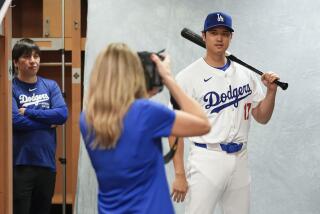Makers of Sporting Goods Hope Their Gizmos Score
WASHINGTON — Randy Black thinks he has the sports sensation of 1998 in the baseball that clocks itself. Don’t hit it, though. It may break.
“The kids love it,” said Black, vice president for marketing at Rawlings Sporting Goods Inc. in St. Louis. “They all want to know how fast they throw.”
The ball is among new products at the Sporting Goods Manufacturers Assn.’s Super Show trade exposition in Atlanta on Feb. 5-8, along with a basketball with handprints and a stuffed frog that croaks college fight songs.
The Rawlings Radar Ball, which the company concedes doesn’t actually use radar, is essentially a clockwork baseball. Its timer starts with the snap of the pitch and stops when the ball slams into the catcher’s glove.
A microchip in the ball converts the time into miles per hour. But the ball cannot itself measure distance, so the readout is based on the assumption that the ball is thrown a regulation distance. The ball can be calibrated for the 46-foot regulation youth-pitching distance in Little League or the 60 feet, 6 inches of college play, Black said. For those without a regulation field, Rawlings throws in a tape measure.
A liquid crystal display in the ball shows the speed. However, if the actual distance thrown is not the one for which the ball is calibrated, the readout would be inaccurate.
The ball, which is expected to retail for under $40, is regulation size. “We had to replace the exact weight so it threw like a baseball,” Black said. “We didn’t want it to be a gimmick.”
One catch in this pitch, however: the Radar Ball’s liquid crystal display isn’t tough enough to bounce off bats. “They are probably going to destroy it,” Black said. The ball is designed only as a training aid to help people throw, he said.
Also at the show is a training-aid basketball designed by a youngster who was appalled at his friends’ poor shooting forms. At the age of 9, Chris Haas of Murrieta, Calif., drew hands on a ball to show the correct positions for shooting.
That seemed like such a good idea that he submitted a decorated ball to his school’s Invention Convention--where it did not win. But teachers encouraged him to keep trying and to get a patent, which he did. Sportime, a national catalog distributor of sporting goods for physical education programs, then picked up Haas’ Hands on Basketball.
The catalog concedes that this is not the only basketball with hand positions printed on it. But it notes that it was designed by a 9-year-old, and contends that this gives Haas the edge in understanding what kids need.
For those who’d rather cheer than play, fight songs seem big this year.
Sound Around of Plymouth, Mich., markets trinkets such as key chains and ballpoint pens that play college songs. A microchip holds the music; in the pen, it’s played through a tiny speaker in the top.
People eat this stuff up, said Martin Schine, Sound Around’s president. “Our products are not really products,” he said. “They are only an emotion that plucks at the heartstrings of the true-blue fan, and there are millions of them.”
Country Mini Ponds of Unionville, Tenn., markets a frog that, when its left foot is pressed, will croak a college fight song.
It started in January with the University of Tennessee favorite, “Rocky Top,” and business has been leapfrogging since, to other colleges, said Louise Crowell, who owns Country Mini Ponds with her husband, Allen. “He kept bugging me about it, and finally, I made one,” she said.
Since then, the frog trade has grown to 47 colleges, and it’s hard to keep the frogs in stock, Crowell said. That’s partly because frogs of any kind have become a kind of a fashion statement, she said, noting that “I have people come up to me who have frog rings, frog necklaces--everything.”
But it may also be that sports fan-type guys are not embarrassed by frogs, Crowell said.
“My husband explained it to me--that men, they are not going to go for a teddy bear or a Barbie doll or anything like that,” Crowell said. “But a frog, they can relate to. I think it’s a more masculine character.”
More to Read
Inside the business of entertainment
The Wide Shot brings you news, analysis and insights on everything from streaming wars to production — and what it all means for the future.
You may occasionally receive promotional content from the Los Angeles Times.










